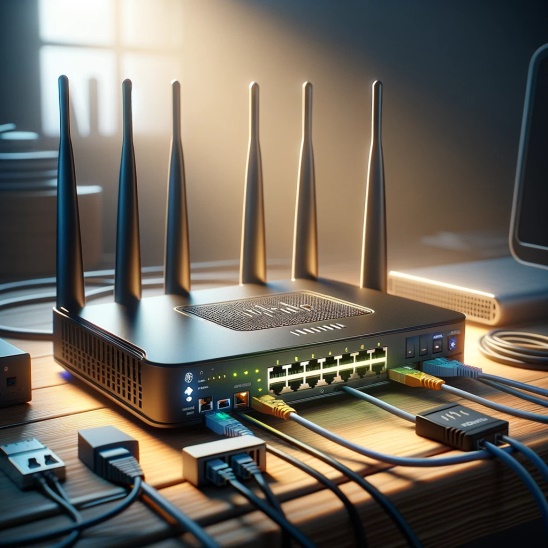Cisco Router Setup
In the fast-paced digital landscape, the importance of secure and efficient network infrastructures is paramount. Cisco switches and routers, as leading figures in network technology, present sophisticated solutions for navigating complex network environments. However, unleashing the full potential of these devices hinges on precise configuration. From cisco switch configure ssh, to cisco ospf setup for optimized network routing, along with configure dhcp cisco router for automated IP management, and extending to managing external connections through BGP, the range of configurations is broad and diverse.
The criticality of correctly configuring Cisco devices for network security and performance is fundamental. Secure configurations, such as enabling ssh on cisco switch, prevent unauthorized access and protect sensitive data. Simultaneously, efficient configurations guarantee uninterrupted communication, high availability, and superior performance throughout the network. This guide dives deep into the vital configurations for Cisco devices, emphasizing cisco switch ssh setup, and cisco router to router configuration, among others. By mastering these configurations, network administrators can shield their networks from evolving threats and enhance their infrastructure for future growth and robustness.
The subsequent sections will thoroughly examine each of these essential configurations, offering practical advice and detailed instructions to ensure your Cisco devices are primed for utmost security and efficiency. Whether you aim to enable SSH for secure management via cisco switch configure ssh, deploy OSPF for efficient routing with cisco setup ospf, implement DHCP for seamless IP allocation by configure cisco router as dhcp server, or employ BGP for reliable external routing, this guide provides extensive insights to cater to your requirements.
Configuring SSH for Cisco Router Setup:
Secure Shell (SSH) is a protocol essential for secure remote management of network devices, providing a secure channel over an unsecured network. For Cisco devices, configuring SSH is a critical step in safeguarding against unauthorized access and ensuring that management sessions remain encrypted. This section will cover the basics of SSH configuration on Cisco switches and routers, incorporating high-density keywords to guide you through the process.
-
Understanding SSH Configuration
Before diving into the configuration steps, it’s crucial to understand what SSH offers. Unlike its predecessor, Telnet, SSH provides encryption, ensuring that all data exchanged during the session, including login credentials, are secure from eavesdropping. This makes cisco switch configure ssh not just a task, but a necessity for modern network security practices.
-
Step-by-Step Guide to Configure SSH on Cisco Router
-
-
Set the Hostname and Domain Name:
-
Before enabling SSH, ensure your device has a unique hostname and domain name. These are essential for generating the RSA key-pair used in encryption.
-
-
Generate RSA Key-Pair:
-
Use the Cisco key generate rsa command to create the key-pair. This step is critical for enabling SSH since it provides the cryptographic keys necessary for secure communications.
-
-
Enable SSH on the Cisco Switch:
-
Follow with ip ssh version 2 command to enable SSH Version 2, offering enhanced security features over the older version.
-
-
Configure User Authentication:
-
Set up local user authentication with a username and password to ensure that only authorized users can access the device via SSH.
-
-
Verify SSH Configuration:
-
Use the show ip ssh and show ssh commands to verify your SSH configuration and ensure that the service is running correctly.
By following this Step-by-step guide to configuring SSH on Cisco switches you can ensure that your Cisco devices are securely managed over the network, providing a strong foundation for your network’s security posture. This section has not only covered the essential steps for Cisco switch configure ssh but also provided insights into making the configuration as secure and efficient as possible.
Detailed Setup Guide for Cisco OSFP Setup:
Open Shortest Path First (OSPF) is a reliable, link-state routing protocol used to determined the best path for packets as they navigate through IP networks. Renowned for its efficiency and scalability, OSPF is a favored choice for large enterprise networks. This section will delve into “cisco ospf setup, exploring the protocol’s benefits and providing a detailed guide for configuring OSPF on Cisco devices.
-
Define Cisco OSPF Routing Process:
Initiate the OSPF configuration by defining a routing process with a unique process ID using the router ospf [process-id]
-
Configure Cisco OSPF Network Statements:
Network statements are crucial for specifying which interfaces will participate in OSPF. Use the network [ip address] [wildcard mask] area [area-id] command to include interfaces in the OSPF process.
-
Assign Area IDs:
OSPF’s hierarchical structure uses areas to optimize routing. Ensure each network statement is assigned an appropriate area ID, with Area 0 being the backbone area.
-
Verify Cisco OSPF Configuration:
Use commands like show ip ospf and show ip ospf neighbor to verify OSPF neighbors and the state of the OSPF process on your Cisco device.
-
Advanced Cisco OSPF Configuration (Optional):
Consider advanced OSPF configurations such as setting OSPF priorities, configuring authentication for OSPF areas, and fine-tuning the OSPF cost metric for optimal performance.
By following this guide on Configuring OSPF in Cisco routers for beginners, network administrators can leverage the full potential of OSPF to create dynamic, resilient, and efficient network topologies. This detailed setup guide ensures that even those new to OSPF can understand and implement this powerful routing protocol on their Cisco devices, enhancing network performance and reliability.
Setup DHCP on Cisco Switch:
Dynamic Host Configuration Protocol (DHCP) is a critical network management protocol used by devices (DHCP clients) can ask for and receive an IP address, as well as additional network settings automatically from a DHCP server, streamlining network administration. This section focuses on how to configure dhcp cisco router, emphasizing the importance of DHCP in modern networks and providing a comprehensive guide to configuring Cisco router as a DHCP server.
-
Define the DHCP Pool:
Start by defining a DHCP pool using the ip dhcp pool [name] This pool will contain the range of IP addresses available for assignment.
-
Configure the Network and Default Router:
Specify the network and subnet mask associated with the DHCP pool using the network [network-number] [subnet-mask] Then, set the default gateway (router) with the default-router [ip address] command.
-
Specify DNS Settings and Lease Time:
Use the dns-server [ip address] command to define the DNS server IP addresses for the clients. Adjust the lease time for IP addresses with the lease [days] [hours] [minutes] command, according to your network’s needs.
-
Exclude IP Addresses:
To prevent IP conflicts, exclude addresses that are statically assigned or reserved by entering the ip dhcp excluded-address [start-ip] [end-ip]
-
Verify the DHCP Configuration:
Ensure your DHCP server is functioning correctly by using the show ip dhcp binding command to view assigned IP addresses and the show ip dhcp pool command to see pool details and utilization.
By following these guidelines for Cisco router DHCP configuration and management best practices, network administrators can streamline IP address management, enhance network efficiency, and maintain optimal performance across all devices. This comprehensive approach to DHCP setup on Cisco routers ensures networks remain dynamic, scalable, and secure.
Advanced Router Configuration: BGP and NAT:
Mastering advanced routing configurations such as Border Gateway Protocol (BGP) and Network Address Translation (NAT) is crucial for network administrators aiming to optimize routing efficiency and enhance network security. This section focuses on cisco bgp config and how to configure nat on cisco router, providing insights into implementing these technologies to improve network performance and security.
-
A Step-by-Step Guide for Cisco BGP Configuration
-
Define the BGP Routing Process:
-
Initiate the BGP process by specifying a BGP AS number using the router bgp [AS number] This unique identifier is crucial for the BGP configuration.
-
-
Configure BGP Neighbor Relationships:
-
Establish connections with other BGP routers by configuring neighbor relationships using the neighbor [IP address] remote-as [AS number] This step is vital for the exchange of routing information.
-
-
Advertise Networks:
-
Use the network [network address] mask [subnet mask] command to advertise your networks through BGP, enabling other ASes to learn about your networks.
-
-
Adjust BGP Parameters (Optional):
-
Fine-tune your BGP configuration by adjusting parameters such as route maps, weight, and local preference to control path selection and traffic flow.
-
Configuring NAT on Cisco Routers:
-
Identify Inside and Outside Interfaces:
-
Use ip nat inside and ip nat outside commands to designate interfaces on your router as inside (private network) or outside (Internet-facing).
-
-
Create Access Control Lists (ACLs):
-
Define which local IP addresses are eligible for NAT using ACLs with the access-list [number] permit [IP address] [wildcard mask]
-
-
Configure NAT Translation:
-
Link your ACL to NAT using ip nat inside source list [ACL number] interface [interface name] overload command, enabling many inside (private) IP addresses to share a single outside (public) IP address.
-
-
Verify NAT Configuration:
-
Ensure NAT is correctly configured and operational by using the show ip nat translations and show ip nat statistics
By mastering cisco bgp config and learning how to configure nat on cisco router, network administrators can significantly enhance their network’s routing efficiency and security. Implementing these advanced configurations requires careful planning and monitoring but ultimately leads to a more robust and efficient network infrastructure.
FAQs for Cisco Router Setup:
Q. How do I configure SSH on a Cisco switch?
- A. To cisco switch configure ssh, start by setting a hostname and domain name on the switch, generate RSA keys with crypto key generate rsa, and then enable SSH with ip ssh version 2.
Q. What are the steps for enabling SSH on a Cisco switch?
- A. Enabling ssh on cisco switch involves configuring a hostname, domain name, generating RSA encryption keys, creating a user with a password, and enabling SSH on the device.
Q. Can you explain the process to setup SSH Cisco?
- A. To setup ssh cisco, ensure your device has a unique hostname, domain, generate RSA keys, and configure SSH access with a secure password for user authentication.
Q. How do I perform a Cisco OSPF setup?
- A. For cisco ospf setup, use the router ospf [process-id] command to start the OSPF process, then use network statements to specify interfaces to participate in OSPF.
Q. What are the initial steps to configure DHCP on a Cisco router?
- A. To configure dhcp cisco router, define a DHCP pool, specify the network and subnet, set a default router (gateway), and optionally configure DNS servers.
Q. How do I configure a Cisco router as a DHCP server?
- A. Configure cisco router as dhcp server by entering the DHCP configuration mode with ip dhcp pool [name], specifying network details, and setting up a default gateway.
Q. What is involved in DHCP configuration Cisco?
- A. DHCP configuration cisco includes creating a DHCP pool, assigning IP address ranges, configuring default gateway, DNS settings, and excluding specific IP addresses from the pool.
Q. How do you set up BGP on a Cisco device?
- A. To cisco bgp config, initiate BGP using router bgp [AS number], configure neighbor relationships with neighbor [IP address] remote-as [AS number], and advertise necessary networks.
Q. What steps are required to configure NAT on a Cisco router?
- A. Configure nat on cisco router by defining inside and outside interfaces with ip nat inside and ip nat outside, creating access lists for eligible traffic, and setting up NAT rules.
Conclusion for Cisco Router Setup:
Mastering the intricacies of Cisco device configurations is essential for creating a secure and efficient network infrastructure. Key configurations such as Cisco switch configure ssh are fundamental for securing remote access, ensuring that network management is both secure and efficient. Similarly, “enabling ssh on cisco switch” enhances network security by providing encrypted management sessions.
For dynamic routing optimization, cisco ospf setup is critical, allowing for efficient routing within an autonomous system. This setup, alongside “cisco router setting” and “cisco router to router configuration,” lays the foundation for a resilient network that can dynamically adjust to changing network topologies and traffic patterns.
In the realm of network management, configure cisco router as dhcp server is pivotal. These configurations streamline the assignment of IP addresses, reducing manual overhead and ensuring devices can connect seamlessly to the network. This is especially important in complex environments where manual IP management would be impractical.
Furthermore, the integration of technologies like “setting up airport extreme” demonstrates the importance of configuring network devices to work seamlessly with a variety of networking equipment, ensuring compatibility and performance across diverse environments.
Through careful application of configurations like cisco ospf setup, configure dhcp cisco router, and advanced security and routing protocols, network administrators can create networks that are not only secure against potential threats but also optimized for performance and scalability. Whether it involves enabling ssh on cisco switch, optimizing routes with OSPF, or managing IP addresses with DHCP, each configuration step contributes to a network that is robust, efficient, and prepared for the demands of the digital age.
To know more about Cisco Router Setup and resolve its related issues, visit Cisco Support page.


Anthony baker
I’m trying to enhance the security of my network by enabling SSH on our Cisco switches. Could you provide a detailed guide on how to configure SSH on a Cisco switch, including any prerequisites?
CallSupport
Certainly! To improve your network’s security by configuring SSH (Secure Shell) on your Cisco switches, you’ll need to follow a structured process. The procedure for enabling SSH on a Cisco switch is an essential security measure, ensuring encrypted management sessions and safeguarding against unauthorized access.
Firstly, ensure your switch has a unique hostname and a domain name set, as these are prerequisites for SSH configuration. Use the hostname command to set a hostname and the ip domain-name command for the domain name. Next, generate a cryptographic key pair (RSA keys) with the crypto key generate rsa command, which is necessary for encryption.
After setting up the basics, you can enable SSH on your Cisco switch. Specify the SSH version, preferably version 2, for enhanced security with the ip ssh version 2 command. Lastly, set up a local user database with usernames and passwords for authentication by using the username command.
This step-by-step guide not only fortifies your network by enabling SSH on your Cisco switch but also lays the foundation for secure remote management. Always verify your configuration with show ip ssh and show ssh commands to ensure SSH is operational.
Steven rivera
We’re planning to deploy OSPF on our network. How can we proceed with the Cisco OSPF setup, and what are the key considerations for Cisco router to router configuration using OSPF?
Support Admin
Deploying OSPF (Open Shortest Path First) for your network involves a detailed setup process on your Cisco routers, crucial for creating an efficient and scalable routing environment. The Cisco OSPF setup is a fundamental aspect of network configuration, enabling dynamic routing within your network.
Begin by initiating the OSPF routing process on your Cisco router with the router ospf [process-id] command, where [process-id] is a unique identifier for this OSPF instance. It’s crucial for router-to-router communication.
The next step involves defining which interfaces will participate in OSPF using network statements. These statements include the IP address, wildcard mask, and area designation with the network [ip address] [wildcard mask] area [area-id] command. Remember, area 0 is the backbone area, and connecting all OSPF areas to it is vital for proper OSPF operation.
Also, ensure consistent OSPF configurations across all routers to enable seamless router-to-router communication. This includes matching area IDs, OSPF process IDs, and ensuring all routers within the same area share the same subnet configurations.
This approach to Cisco OSPF setup and router-to-router configuration paves the way for a robust, self-healing network, capable of quickly adapting to network topology changes.